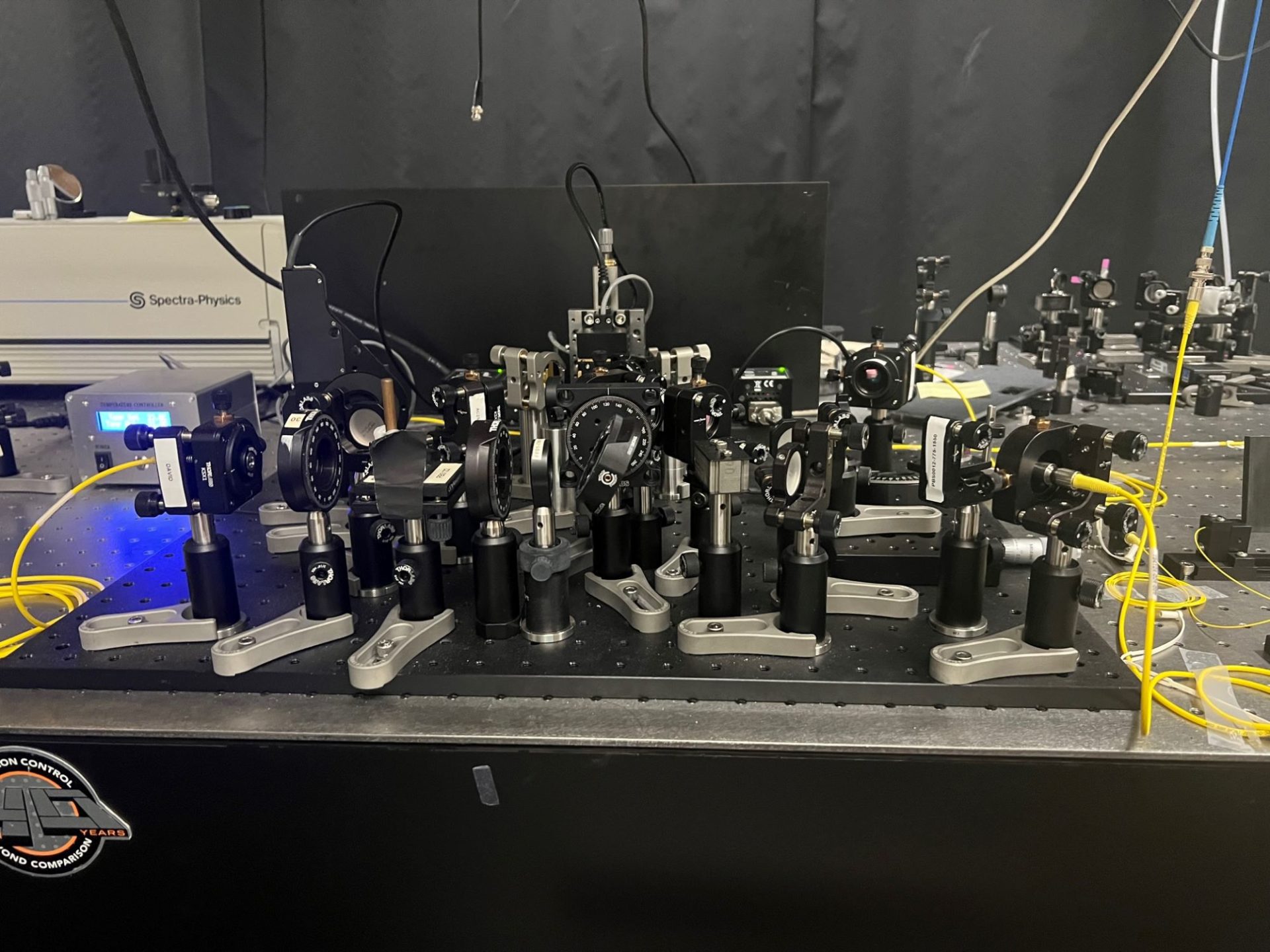On Saturday, November 4th, with more than 200 people in attendance, a team of researchers from The Grainger College of Engineering at the University of Illinois launched the first public quantum network in the entire world at one of our own public libraries. The launch event at The Urbana Free Library drew people of all ages to learn about this groundbreaking scientific achievement, and participate in hands-on demonstrations of just how something like this works. They were able to show that there is an actual quantum link between the lab at Loomis Laboratory of Physics on campus, and the library.
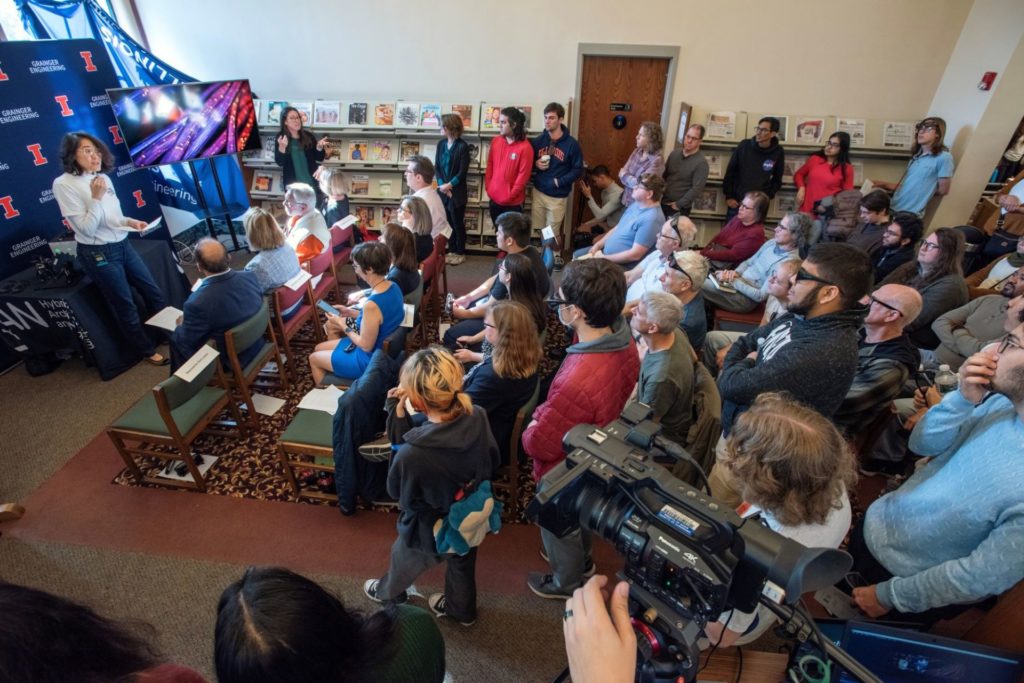
When I learned this event was happening, my thought process went something like this: “Wow, this seems like a really big deal,” followed by “But I have no idea what any of this actually means.” My experience with and knowledge of physics is limited, to say the least, and if I’m being completely honest, I’m a little intimidated by it. My last encounter with learning physics was at the U of I, in Loomis Lab even, in a physics class for non-math and science majors. While I’m sure the instructor did a fine job, it was quite difficult for me to wrap my brain around the concepts that were being imparted to me. We all have different academic strengths. Now you bring in the term “quantum,” and my only base of knowledge is the popular television show from the early 90s, Quantum Leap, starring Scott Bakula as a time-traveling scientist who finds himself embodying other people and talking to a hologram in the form of Dean Stockwell. I’m going to go ahead and assume that this is not an entirely accurate portrayal of quantum science. It was a great show, though, and the name comes from an actual scientific concept. In fact, this quantum network project is being funded with assistance from the NSF Quantum Leap Challenge Institute Hybrid Quantum Architectures and Networks.
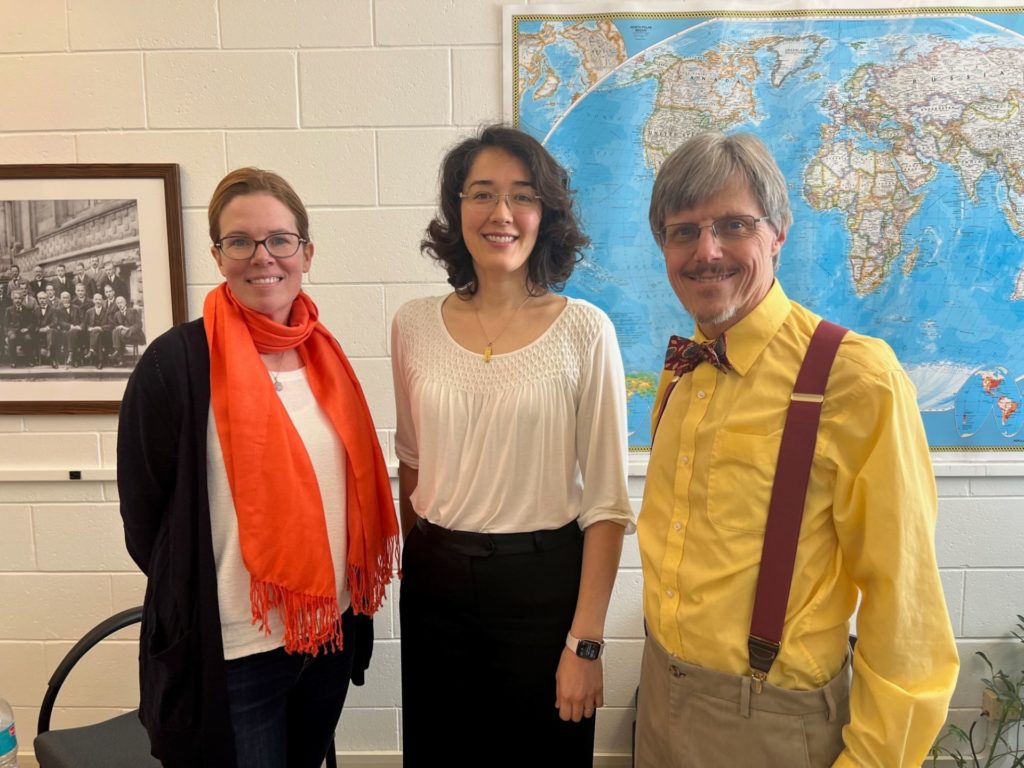
The team working with this newly launched network is committed to making the rather complex concepts behind quantum information science accessible to regular folks like me. I met up with team leaders and U of I Physics professors Virginia (Gina) Lorenz and Paul Kwiat, as well as Emily Edwards, Executive Director of the Illinois Quantum Information Science and Technology Center, to learn more about their work, the basics of creating a quantum network, and how it could potentially impact our community and beyond.
You may be familiar with Kwiat’s work with LabEscape, the science-based escape room that initially operated in Lincoln Square Mall, and is now running regular games at the Digital Computer Lab. It’s one of the many public-facing efforts employed by the Department of Physics to engage the community in this particular scientific field.
Kwiat’s interest in working in quantum physics began as an undergrad, when he read an article published in Physics Today titled “Is the Moon There When Nobody Looks?” The title is a reference to an Albert Einstein quote, and describes experiments involving Bell’s Inequalities which, in Kwiat’s words, demonstrated that “nature is really weird and not explainable by common sense.” He had the opportunity to work in Anton Zeilinger’s postdoc group, who went on to win the 2022 Nobel Prize for Physics along with Alain Aspect and John Clauser.
Lorenz describes herself as a “seeker.” Physics was appealing because, as she says, it “provided the most quantitative way of understanding the way the world worked…it was a way of categorizing questions and finding answers in a reliable way.” Her postdoctoral research was in quantum optics, and after a time on faculty at the University of Delaware, Kwiat invited her to come to the U of I, and they are now leading the team that developed the public quantum network.
Edwards discovered her love of physics in college, and became focused on atomic physics in grad school. “I liked that you could learn about something in a book, like quantum mechanics, and then you could go into a lab and see it happening. I got into science writing and communication because I loved to talk about quantum.” Now she specializes in early learners, bringing these sorts of complex concepts to grades K-12. Says Edwards, “You can see the excitement in kids’ faces, and that to me is so rewarding as a professional.”
I asked the trio to help break down quantum science into its most basic terms. Lorenz offered an explanation that often Edwards uses: “Quantum science is the study of things that are very, very, very, small — down to the levels of atoms,” and continued, “in particular for the quantum network…the internet brings information to our computers. That information is shared using really bright pulses of light. If you take those down to the smallest possible blip of light, it’s a particle called a photon. Quantum science is the study of these particles and what they can do.”
And they can do things differently from other objects. Quantum science relies on the fact that photons and other quantum particles are “entangled”. Edwards put together a “cheat sheet” of terms for the public launch event, and it says simply “entanglement ties quantum particles together, even if they are very far apart.” Lorenz explains that “entanglement is like the gas on which quantum technology runs. That’s going to bring us quantum computers that can solve problems that regular computers can’t.”
Kwiat describes how bits, the unit of data used in computing, are different in classical and quantum computing. “Classical computers are based on bits which can be 0s or 1s, and quantum photons can be 0 and 1 at the same time.”
We are already quite familiar with the products of quantum theory surrounding entanglement. As Edwards describes, “When we look back, [scientists’] ability to understand nature at these levels has led to amazing innovations in the 20th century: MRI, miniaturization of computing to enable how our phones work, putting clocks in space to enable the global positioning system so we can find our way to our favorite restaurant.”
One of the goals of the public quantum network is to bring people into the innovation process, particularly those who are typically left out. As Edwards explains, “we’re trying to bring people in before it’s so big and so foreign that nobody can be a part of it.”
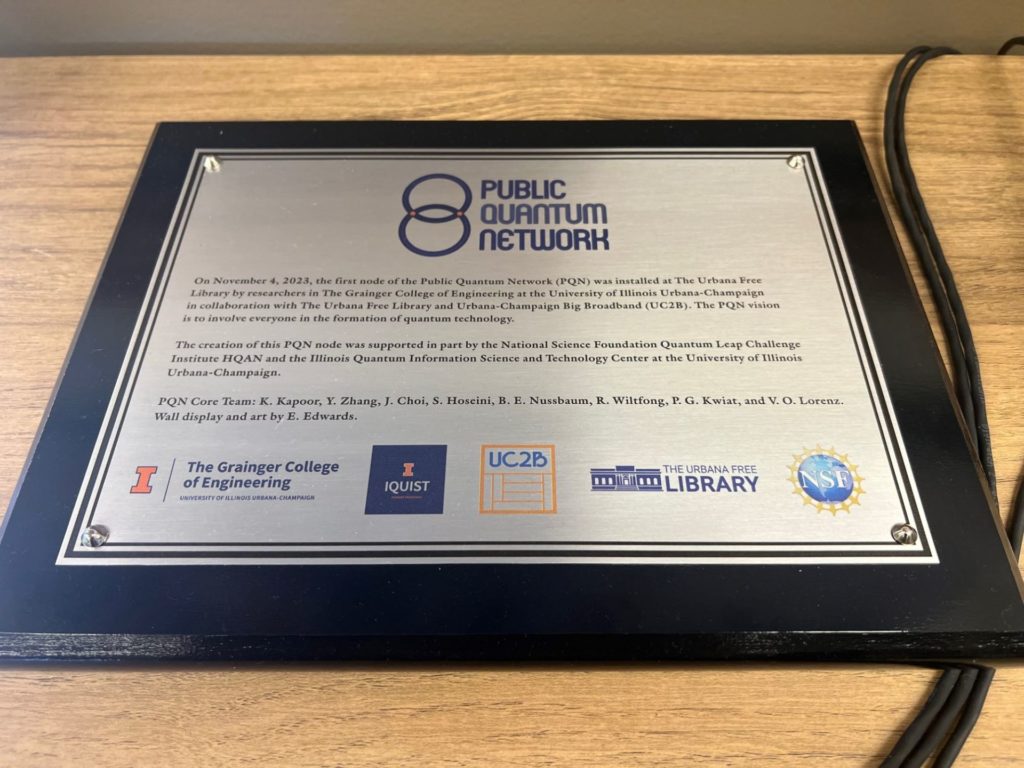
This is where their collaboration with the UC2B Network became an important part of the conversation. Lorenz was introduced to the existence of the broadband network launched with a grant from the 2009 American Recovery and Reinvestment Act, that was specifically created to bring broadband to underserved communities. “It turns out that the fiber is state-of-the-art and suitable for building a quantum network.”
Champaign-Urbana — and more specifically The Urbana Free Library — was an ideal spot to launch this network for those reasons: Access to an all-optical fiber network, and a location that can reach underserved communities. It’s also a network that is an ideal size for sending information. “Any bigger than that,” says Lorenz, “the loss is too great, and you can’t build it. One of our next nodes is in Batavia, and we’re planning one in Champaign. We’re building a fiber link from our labs here, up to the Chicago area. Ultimately the public network here will be linked to a public network up there. But, we have to overcome the loss on that long distance. [We need to] create photons in a fast enough way that you always have enough.”
Kwiat explains further that you need detectors, which function like a signal repeater in a classical network. “Quantum information is totally different from classical information, in that you cannot copy it. You need much more sophisticated quantum repeaters, and there are lots of people working on them. I would say at the moment the world does not have a quantum repeater. Ten years from now we will…We’re really lucky to have the UC2B fiber and the ICN [Illinois Century Network] fiber from the state to connect us to Chicago.”
This is an ever-developing field, and the team feels that bringing something like this to the public sphere is key to seeing what will come of this technology.
“We don’t know what all the applications will be,” says Lorenz. “This is a very early stage for this quantum technology, but the hope is that bringing people in early will lead to more applications that we haven’t thought of.” Edwards adds, “The field is really rich, and quantum hasn’t been really tested in the wild in this way. We need partnerships that deploy in public spaces to really pressure test it, and see how it’s going to behave. That’s going to drive innovation in the field, and also in adjacent technologies like fiber infrastructures.”
Kwiat sums it up this way: “It’s really hard to say if we look 30 years from now, what the quantum network is going to look like, and what it is going to be used for. My hope is that it’s going to be wonderful in ways that we just aren’t imagining. Most of the ideas are going to come from people who are just starting to learn about things now. They have to know enough about it to not be afraid of it.”
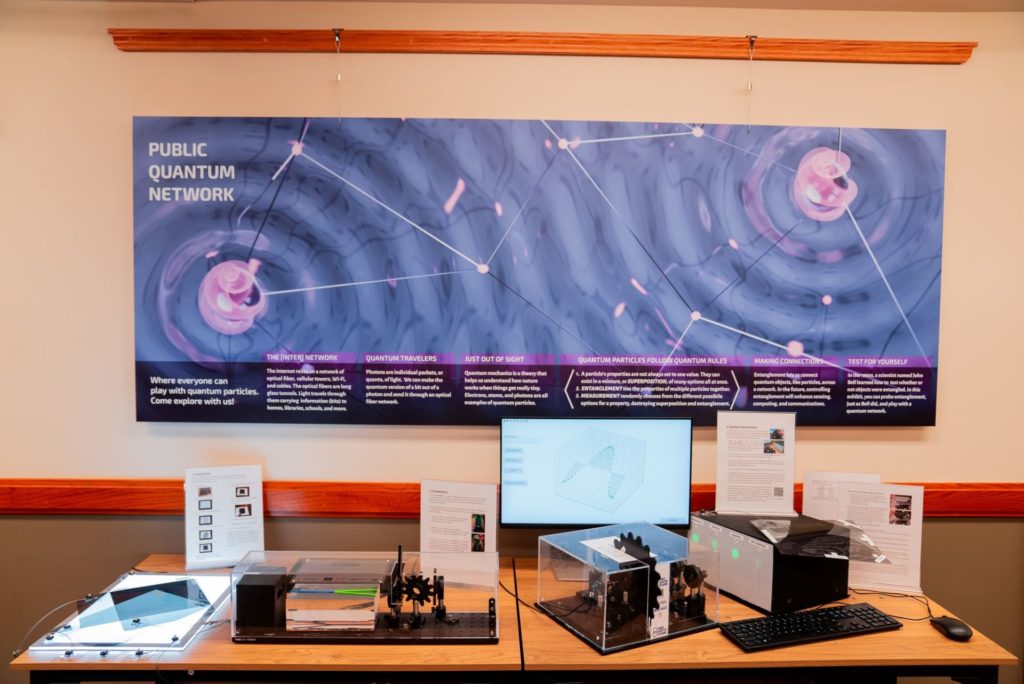
Anyone can visit the quantum network display at The Urbana Free Library. You’ll find it on the main floor, just across from the elevators. You can learn more about this research at Grainger’s Illinois Quantum Information Science and Technology Center website, or explore these sites that are meant for kids and/or non-experts:
- Multimedia glossary for non-experts of any age (was designed with adults in mind, but is friendly for any age)
- Quantum activities for kids
- Quantum video aimed at students
- A few other quantum video playlists








